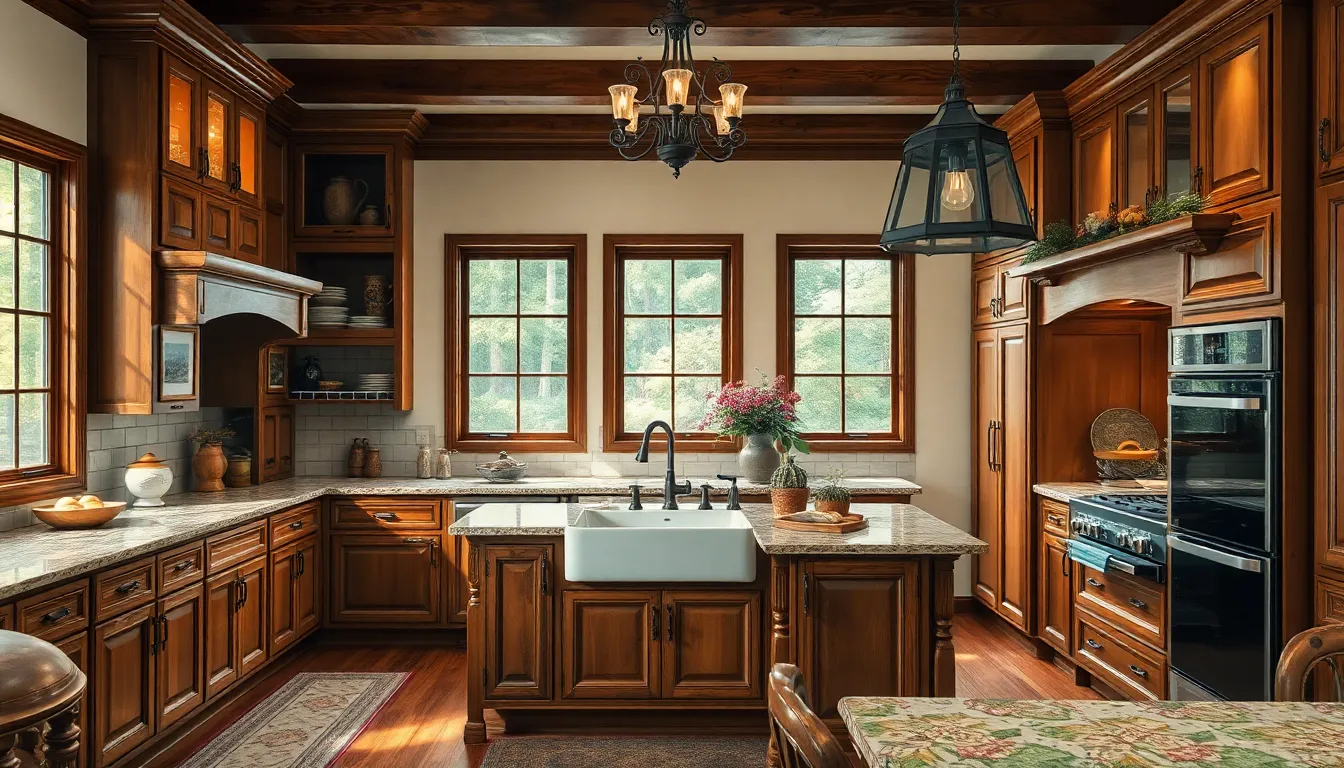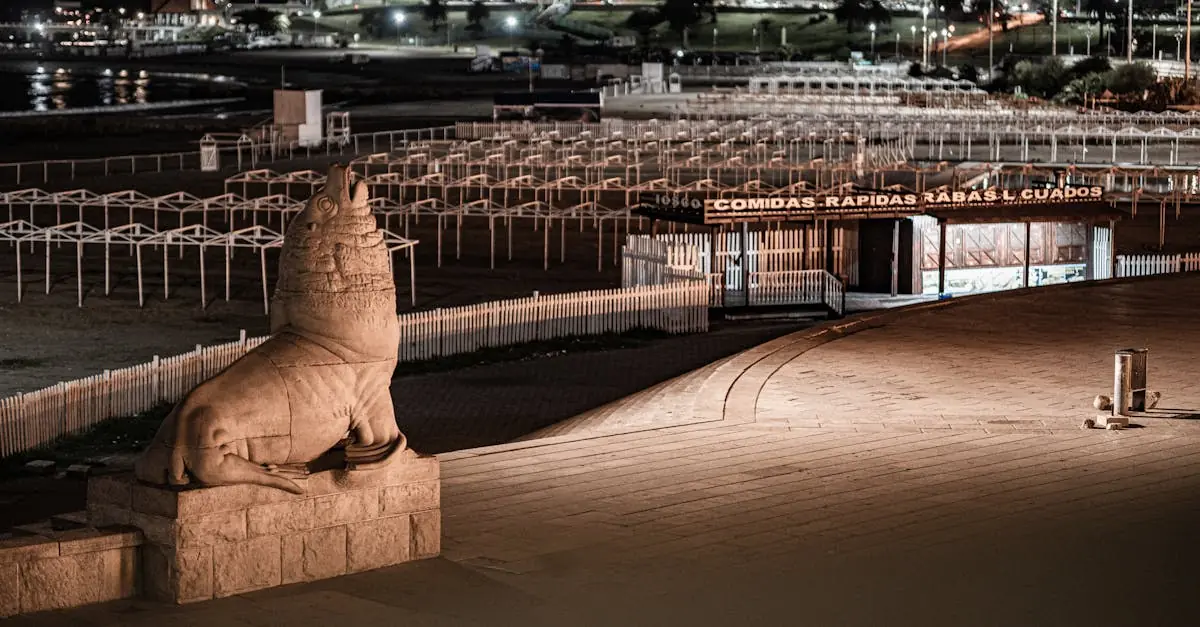In a world where sleek lines and minimalism reign supreme, traditional kitchen design stands as a charming rebel. Imagine a space where warm wood tones, intricate moldings, and vintage accents invite you to whip up a family recipe or sip coffee while reminiscing. It’s like stepping into a cozy cottage or your grandma’s kitchen, where every corner tells a story and the aroma of baked goods lingers in the air.
Traditional kitchens aren’t just about aesthetics; they’re about creating a welcoming atmosphere that feels like home. With their timeless appeal and classic charm, these kitchens blend functionality with nostalgia, making them the perfect backdrop for culinary adventures and unforgettable gatherings. So, if you’re ready to trade in the cold, sterile vibes for a space that feels alive, let’s dive into the world of traditional kitchen design and discover how to bring that warmth into your home.
Table of Contents
ToggleOverview of Traditional Kitchen Design
Traditional kitchen design emphasizes warmth and comfort, creating an inviting atmosphere. Characterized by rich wood tones, these kitchens often feature cabinetry with intricate moldings. Vintage accents enhance the overall charm, blending functionality and aesthetics seamlessly.
Elements such as farmhouse sinks and ornate backsplashes define the space. Natural materials like stone or brick contribute to the timeless quality, promoting a rustic yet refined appearance. Accessories, including antique hardware and open shelving, personalize the kitchen further.
Design layouts often prioritize central islands, encouraging communal cooking and socializing. Soft, ambient lighting complements the cozy feel, using pendant lights or chandeliers to create a welcoming glow. Color palettes typically include earthy tones, providing a soothing backdrop for daily activities.
Traditional kitchens also allow for a range of decorative styles. From country chic to classic elegance, there are countless variations to explore. The balance of form and function makes these kitchens highly adaptable to individual preferences and lifestyles.
Ultimately, traditional kitchen design offers a nostalgic connection to home. It resonates with individuals seeking a blend of timeless beauty and everyday practicality. This style cultivates a space where family and friends gather, fostering cherished memories over shared meals.
Key Features of Traditional Kitchens

Traditional kitchens feature numerous elements that create a warm and inviting atmosphere, emphasizing a blend of style and functionality.
Cabinetry and Millwork
Cabinetry serves as a focal point in traditional kitchens. Custom wood cabinets often showcase intricate moldings and classic details. Stately raised paneling typically enhances the overall aesthetic. Curved or decorative crown molding adds final touches that elevate the design. Open shelving invites displays of heirlooms, promoting a personal touch. Antique or vintage-style hardware, like drawer pulls and knobs, completes the look with authenticity. Natural wood finishes, often in shades like oak or cherry, add richness while contributing to an overall rustic charm.
Color Palette and Materials
Color palettes in traditional kitchens lean toward earthy tones. Soft creams, warm browns, and deep greens commonly create a soothing backdrop for various activities. These hues evoke feelings of comfort and nostalgia. Materials play an important role; natural elements such as granite, marble, and reclaimed wood are frequently utilized. Stone backsplashes often enhance durability while maintaining an elegant appearance. Fabrics for curtains and upholstery typically feature patterns or textures that reflect traditional craftsmanship. Together, these colors and materials foster an inviting environment ideal for cooking and socializing.
Popular Styles Within Traditional Design
Traditional kitchen design encompasses various styles, each offering unique characteristics and charm. Two popular styles within this design are French Country and Shaker Style.
French Country
French Country kitchens exude warmth and rustic elegance. Features often include distressed wood cabinetry, exposed beams, and ornate details that reflect the countryside’s charm. Soft, muted colors enhance the comforting atmosphere, while floral patterns in textiles or wallpapers add a touch of whimsy. Antique-styled accessories, such as wrought iron and ceramic pieces, complete the look. This style combines functionality with an inviting environment, perfect for family gatherings and hearty meals.
Shaker Style
Shaker Style emphasizes simplicity and craftsmanship. Characterized by clean lines and minimal ornamentation, cabinetry often showcases flat-panel doors and natural finishes. The focus remains on functionality, with open shelving providing access to dishes and ingredients. Neutral color palettes, featuring whites, grays, and earth tones, create a serene backdrop. Practical accessories align with the Shaker ethos, promoting a clutter-free space. Overall, this style offers a timeless appeal that resonates through its emphasis on utility and design integrity.
Benefits of Traditional Kitchen Design
Traditional kitchen design offers several advantages that enhance both aesthetics and functionality. One major benefit is its inviting atmosphere, which fosters warmth and comfort. Rich wood tones and intricate moldings create an appealing visual landscape, making spaces feel more like home.
Functionality stands out in traditional kitchens. Central islands often serve as multi-purpose workspaces while encouraging family interactions during meal preparation. Open shelving allows easy access to dishes and decorative items, promoting a casual, welcoming environment.
Durability is another key benefit. Natural materials like granite and marble withstand daily use, ensuring long-lasting appeal. These materials combine well with classic cabinetry, showcasing detailed craftsmanship that elevates the kitchen’s overall design.
Versatility also defines traditional kitchens. They easily adapt to various styles, whether French Country or Shaker Style. This flexibility attracts a wide range of homeowners seeking personal expression in their kitchen spaces.
Emotional connection enhances the appeal of traditional kitchen design. These kitchens often evoke nostalgic feelings reminiscent of cherished family gatherings and moments shared over meals. A focus on timeless aesthetics ensures that traditional kitchens maintain their relevance and charm, regardless of changing design trends.
Finally, accessibility in traditional designs includes elements like wide pathways and thoughtful layouts that make the kitchen user-friendly for all ages. Enhancements in lighting, such as pendant lights or chandeliers, contribute to a warm ambiance, perfect for both functional cooking and entertaining guests.
Tips for Achieving a Traditional Kitchen Look
Choosing the right materials is essential. Opt for oak, cherry, or maple wood for cabinetry. Natural stone countertops, such as granite or marble, complement the inviting aesthetic.
Incorporating ornate details enhances visual interest. Consider crown molding and embellishments that reflect craftsmanship. Antique hardware on cabinetry contributes to authenticity.
Selecting a warm color palette creates a cozy atmosphere. Soft creams and warm browns set the foundation, while deep greens or muted blues can add depth. Appropriate wall coverings, like shiplap or beadboard, also help achieve that traditional charm.
Integrating vintage accents adds character. Decorative elements, such as farmhouse sinks or patterned backsplashes, evoke nostalgic feelings. Vintage-inspired appliances maintain functionality while enhancing the overall look.
Arranging the layout for functionality is vital. Central islands promote socializing and cooking. Ensure that open shelving displays cherished dishware or antique items for added personality.
Choosing lighting fixtures sets the mood. Elegant chandeliers or classic pendant lights provide ambiance. Incorporating soft lighting enhances the warmth and invites gatherings.
Focusing on textiles adds comfort. Patterns in curtains, tablecloths, or upholstered seating reflect traditional craftsmanship. Warm fabrics contribute to an inviting atmosphere.
Lastly, personal touches elevate the space. Family heirlooms or handmade pottery create connections to cherished memories. Incorporating individual elements ensures that each traditional kitchen tells its unique story.
Traditional kitchen design stands out as a timeless choice that marries beauty with practicality. Its warm tones and intricate details create a space that invites family and friends to gather and share meals. By incorporating natural materials and personal touches, homeowners can craft a kitchen that reflects their unique style and fosters cherished memories.
Whether opting for the rustic charm of French Country or the simplicity of Shaker Style, traditional kitchens offer a versatile canvas for creativity. With careful consideration of layout and design elements, these kitchens remain relevant and appealing. Embracing traditional design not only enhances the home but also nurtures the heart of family life.







